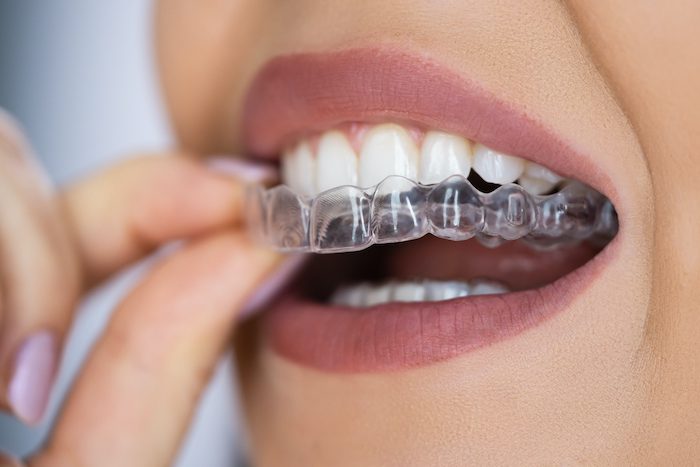Invisalign is a revolutionary orthodontic process that has changed how people think about getting a straighter smile. For too long, traditional metal braces were the only option to straighten teeth. Many people don’t want the look of metal braces on their teeth. Invisalign is a cosmetic dentistry treatment that can discreetly give you the smile of your dreams.
Getting Invisalign in Denton, TX
The Invisalign process starts with a consultation in our office. We want to ensure that Invisalign is the best option for your needs. We’ll talk to you about your cosmetic goals and budget for care. We perform a thorough oral exam as well. Invisalign works best for patients with mild to moderate orthodontic concerns. Severe orthodontic problems may require more extensive treatment.
If Invisalign is the right choice for you, we take impressions of your mouth so that your clear aligners can be custom-made. Invisalign clear aligners are made of a patented flexible plastic material called SmartTrack. They’re comfortable and clear, so it’s hard for anyone to realize you’re wearing them.
For Invisalign treatment, you change different sets of aligners to slowly move your teeth into the ideal placement. You get new aligners around every two weeks. On average, Invisalign treatment is shorter than that of traditional braces. It usually lasts around a year for most patients, depending on their condition.

Why Straighten Crooked Teeth?
Many people come to straighten crooked teeth because they’re unhappy with their appearance. But crooked teeth are more than just a cosmetic issue. They can also be the cause of various different oral health problems.
To start, crooked teeth are harder to clean than properly aligned ones. They come together at odd angles, often overlapping. They’re cramped, and it’s hard to properly clean between them. Sometimes, even specialized dental tools can’t clean them successfully. Even if you’re taking care of them properly, you still have plaque and tartar building up, putting you at risk for problems like tooth decay and gum disease.
Crooked teeth also lead to an uneven bite. When your bite comes together, the pressure is evenly distributed throughout your teeth. With crooked teeth, some take on more pressure than others. They wear down faster than your other teeth and are more likely to chip or crack under pressure.
Uneven bites are also one of the biggest influences on TMJ disorders. Because your bite isn’t coming together properly, the jaw doesn’t track the right way. It starts to wear down, and the facial muscles controlling the jaw become strained. TMJ disorders cause pain, tension, and popping in the jaw. You may also develop problems opening and closing your mouth.
The Benefits of Invisalign
Invisalign has many benefits over traditional metal braces. One of the top ones people highlight is how discreet they are. You don’t have brackets and wires prominently displayed on your teeth. The aligners are custom-fit so that they fit your smile perfectly. They’re completely clear, so people can only see them on your teeth if they’re specifically for them.
Treatment time with Invisalign is often shorter than traditional braces as well. Usually, treatment with braces lasts around two years. Invisalign treatment typically takes anywhere from six to eighteen months. Invisalign is usually very cost-effective compared to these other orthodontic methods as well.
With metal braces, you have to make changes to the things you eat and the way you take care of your teeth. You must learn how to properly clean around the brackets and wires, sometimes using specialized tools. You have to avoid chewing gum and eating certain foods that can get stuck in or break the structure of the braces.
Invisalign is only worn for around 22 hours each day. You can take the aligners out to perform your oral healthcare routine and eat. During this time, you can clean your aligners properly as well. You don’t have to change your routine or remove any foods from your diet.
Clear aligners are more comfortable to wear than metal structures on your teeth. Brackets and wires rub against the soft tissue, causing sores and discomfort. The plastic of the aligners is smooth, and it doesn’t pinch the soft tissue where it rests in your mouth.
Taking Care of Your Invisalign Aligners
You have to properly take care of your Invisalign aligners if you want them to work successfully. Every time you take them out, rinse them out with lukewarm water. Don’t use hot water on your aligners because it can warp the material. You should clean them daily, too. Use a soft-bristled toothbrush and mild antibacterial soap or non-abrasive toothpaste. Abrasive toothpaste and harder bristles can scratch or damage your aligners.
At least once a week, do a deep clean of your aligners. Use denture cleaner or Invisalign cleaning crystals mixed with water. You submerge the aligners in the solution, ensuring they’re fully covered for a determined amount of time. These help to sterilize the aligners and remove any odor-causing bacteria. When done, rinse any cleaner residue before placing them back in your mouth.
Clean your teeth thoroughly before putting them back into your mouth when your aligners are out. You want to remove any food debris and buildup. If you put the aligners in when there’s food and debris in there, they hold that against your teeth, making it more likely to cause problems like tooth decay and gum disease.
Storing them properly is crucial when your aligners aren’t in your mouth. Keep them in a ventilated case. Bacteria crave a warm, wet environment, so you want to ensure your aligners get proper airflow. When you take your aligners out to eat, having the case keeps them safe so you don’t accidentally misplace them or throw them away. Clean your case regularly, too, to avoid bacteria and buildup.
Never expose your aligners to excessive heat. This includes leaving them out in the sun — even when they’re in a case –, putting them on a stove or near a hair dryer, or keeping them in a hot car. Heat warps the aligners and can render them unusable for further treatment.
Invisalign FAQs
How long does Invisalign treatment take?
The duration of Invisalign treatment varies depending on the complexity of your case. It also depends on your compliance with wearing the aligners, as your dentist suggests. On average, treatment times range from 12 to 18 months for adults. However, some people with minor alignment issues may see results in about six months. More complex cases may take up to two years of treatment.
How do I care for my clear aligners?
Rinse your aligners with lukewarm water every time you remove them. Every day, you will need to clean your aligners using a soft toothbrush and a special aligner cleaner. Never use toothpaste, as it can be abrasive and damage them. Store your aligners in their protective case when you are not wearing them to avoid loss or damage. Practice good oral hygiene to help keep your aligners clean.
What lifestyle changes do I need to make during my Invisalign treatment?
There are a few changes you will need to make during treatment. You must remove the aligners to eat and care for oral hygiene. Only drink water while wearing Invisalign. For all other drinks, you need to remove your aligners to prevent staining and potential damage. If you smoke, we highly suggest quitting. Also, never chew tobacco. Tobacco can easily stain your aligners and increase your risk of other oral health problems. You will also need to manage your time. It takes time to properly handle your aligners during meals and for cleaning.
What will happen if I fail to wear my Invisalign aligners for 22 hours a day?
If you don’t wear your Invisalign aligners for 22 hours a day, your teeth may not move as the right pace. This can extend your treatment time or cause the aligners to fit poorly. Missing wear time can lead to discomfort when put them back on your teeth. For best results, follow the instructions and wear them consistently.
Can Invisalign treat orthodontic relapse?
Yes, Invisalign can treat orthodontic relapse. Orthodontic relapse happens when teeth shift back to their original positions after braces or other treatments. Invisalign aligners can gently move teeth back into alignment over time. Treatment depends on how much your teeth have shifted, so it’s best to consult your orthodontist to see if Invisalign is right for your situation.
Can Invisalign aligners treat TMJ aligners?
Invisalign aligners can help with TMJ disorder by improving your bite and reducing strain on the jaw joint. If your TMJ issues are from misaligned teeth, Invisalign can move teeth into better positions, which may relieve symptoms. However, there is no guarantee that it will cure your TMJ disorder.
Am I a candidate for Invisalign clear aligner therapy?
You might qualify for Invisalign if you have mild to moderate orthodontic issues. Invisalign can address crooked teeth, gaps, or bite problems. Invisalign works well for teens and adults with fully developed teeth. However, complex cases may require traditional braces. Your dentist will assess your teeth to decide if Invisalign is the best treatment for you.
Schedule a Consultation
Do you think Invisalign is the right choice to straighten your crooked teeth? Call us or schedule an appointment online to get started.
